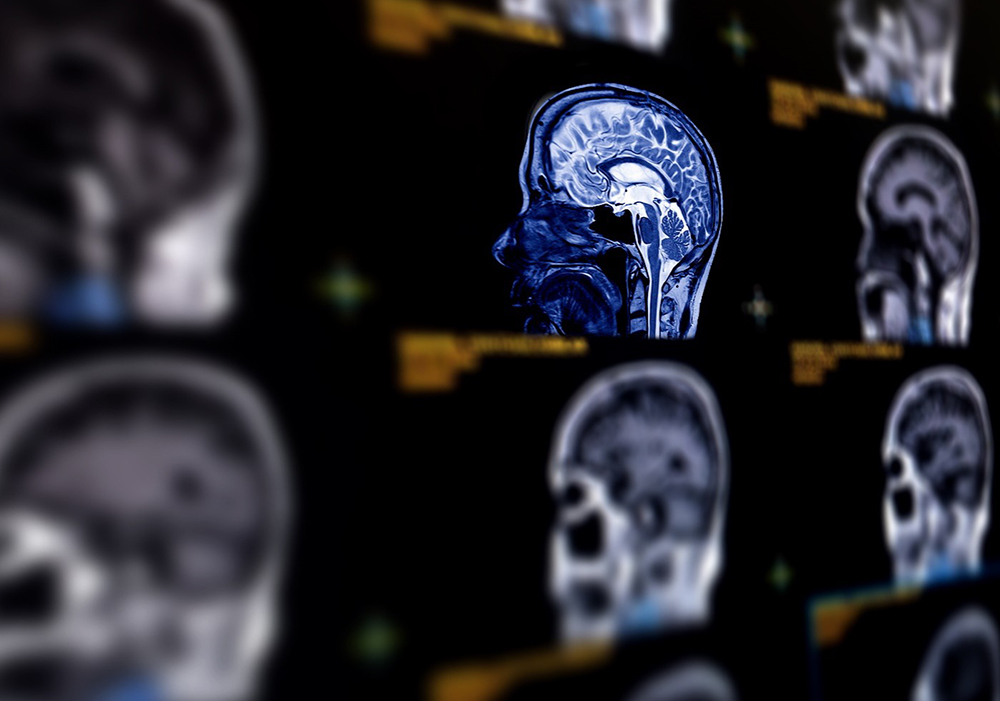Neurofibromatosis type 2 (NF2) is an autosomal dominant disorder characterized by bilateral vestibular schwannomas that can lead to significant hearing loss or deafness. Symptoms include tinnitus, hearing loss, and balance problems, with an average age of onset of 18–24 years and nearly 100% penetrance.
Approximately two-thirds of individuals develop spinal tumors, typically schwannomas. Early manifestations in childhood can include skin tumors and ocular changes (retinal hamartoma, thickened optic nerves, cortical wedge cataracts, third cranial nerve palsy). Other manifestations include schwannomas that develop in other cranial and peripheral nerves, meningiomas, ependymomas, and low-grade astrocytomas. Although many are benign, individuals often have multiple tumors that require frequent monitoring and treatment to prevent debilitating side effects.
NF2 Gene
The NF2 gene provides instructions for making the protein merlin, which is produced in the nervous system in the Schwann cells that surround and insulate neurons. Merlin functions as a tumor suppressor.
As a susceptibility biomarker, NF2 predicts an individual’s risk for various benign and malignant tumors. NF2 is also a prognostic biomarker in that an estimated 50%–75% of patients with NF2 develop meningiomas that are often grade II or III, have a worse prognosis, and have a higher recurrence rate than sporadic meningiomas.
Diagnosis
An NF2 clinical diagnosis is established in a proband with bilateral vestibular schwannomas, a detected germline pathogenic variant, a somatic tumor testing–detected identical NF2 pathogenic variants in two or more anatomically distinct NF2-related tumors, or a combination of the clinical criteria listed in the sidebar (two major criteria or one major and two minor criteria).
Family History
Assessment of family history is important, but approximately 50% of individuals have a de novo pathogenic variant. Of those, 25%–50% have somatic mosaicism, meaning that two or more cell lines with different genetic or chromosomal make-up occur in a single tissue after the zygote has formed. Symptoms of mosaic NF2 are milder and often restricted to a certain area or side of the body.
Offspring of an individual with a germline pathogenic variant have a 50% chance of inheriting the variant; offspring of an individual who has mosaic NF2 may have a lower risk. Once the NF2 pathogenic variant has been identified, cascade testing in other family members is feasible. Testing is usually offered by age 10 so that magnetic resonance imaging (MRI) screening can begin if necessary.
Biomarker Testing
Germline biomarker testing for NF2 typically includes next-generation sequencing (NGS) with multiplex ligation-dependent probe amplification (MLPA) to detect exon to multiexon copy number changes. It may also include high-resolution karyotyping to identify chromosomal rearrangements that NGS/MLPA cannot. The double-pronged approach will detect approximately 96% of germline pathogenic variants and is best coordinated by a genomics professional.
Clinical Management
Early identification of tumors can lead to prompt treatment. Best managed by an interprofessional team with experience in NF2, screening begins at age 10 and includes:
- Annual neurologic exam by a provider familiar with NF2, beginning at the time of diagnosis
- Annual brain MRI, beginning at age 10 through at least age 40
- Annual hearing exam, including brain stem auditory evoked response, beginning at the time of diagnosis
- Annual ophthalmology exam, beginning in early childhood
Treatment
Vestibular schwannomas are surgically removed whenever possible, with the procedure selected based on the tumors’ size and precise location. Radiation therapy may be considered for some individuals, especially those who are not surgical candidates, but it should be used with caution in children because of the substantially higher risk of secondary malignancy. The VEGF inhibitor bevacizumab may also treat rapidly growing schwannomas and has enabled some individuals to regain hearing.
Other NF2 tumors may be benign or malignant. Treatment varies depending on the pathology, size, and location of the tumor. Some tumors may grow slowly and not require active intervention for years.
Retaining a patient’s hearing and hearing rehabilitation are primary management goals. Hearing preservation requires coordination with audiology and speech therapy to assist patients and families in coping with complications, such as by learning to use hearing aids, cochlear implants, and lip reading and sign language.
NF2 has no cure, but promptly identifying and referring families with the disorder to a genetics professional and center with experience managing NF2 can help reduce morbidity and mortality. Families benefit from interprofessional care that includes ongoing psychosocial support and monitoring beginning early in childhood.






